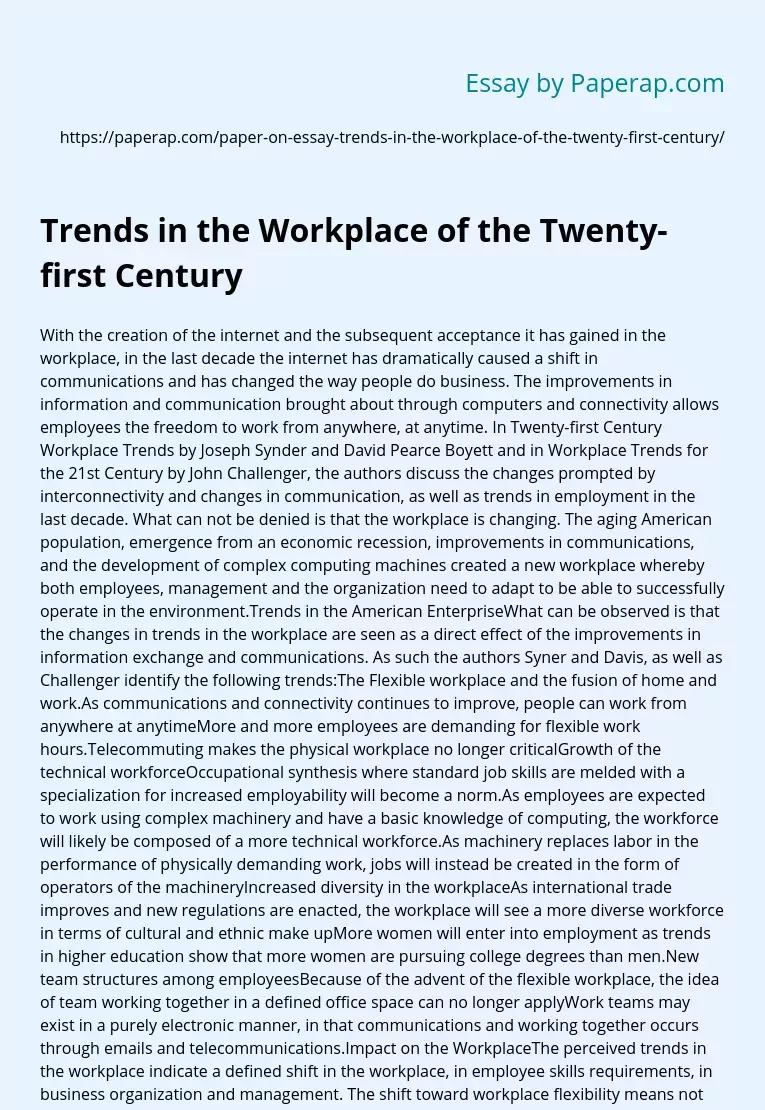Trends in the Workplace of the Twenty-first Century
With the creation of the internet and the subsequent acceptance it has gained in the workplace, in the last decade the internet has dramatically caused a shift in communications and has changed the way people do business. The improvements in information and communication brought about through computers and connectivity allows employees the freedom to work from anywhere, at anytime. In Twenty-first Century Workplace Trends by Joseph Synder and David Pearce Boyett and in Workplace Trends for the 21st Century by John Challenger, the authors discuss the changes prompted by interconnectivity and changes in communication, as well as trends in employment in the last decade.
What can not be denied is that the workplace is changing. The aging American population, emergence from an economic recession, improvements in communications, and the development of complex computing machines created a new workplace whereby both employees, management and the organization need to adapt to be able to successfully operate in the environment.Trends in the American EnterpriseWhat can be observed is that the changes in trends in the workplace are seen as a direct effect of the improvements in information exchange and communications.
As such the authors Syner and Davis, as well as Challenger identify the following trends:The Flexible workplace and the fusion of home and work.As communications and connectivity continues to improve, people can work from anywhere at anytimeMore and more employees are demanding for flexible work hours.Telecommuting makes the physical workplace no longer criticalGrowth of the technical workforceOccupational synthesis where standard job skills are melded with a specialization for increased employability will become a norm.
As employees are expected to work using complex machinery and have a basic knowledge of computing, the workforce will likely be composed of a more technical workforce.As machinery replaces labor in the performance of physically demanding work, jobs will instead be created in the form of operators of the machineryIncreased diversity in the workplaceAs international trade improves and new regulations are enacted, the workplace will see a more diverse workforce in terms of cultural and ethnic make upMore women will enter into employment as trends in higher education show that more women are pursuing college degrees than men.New team structures among employeesBecause of the advent of the flexible workplace, the idea of team working together in a defined office space can no longer applyWork teams may exist in a purely electronic manner, in that communications and working together occurs through emails and telecommunications.Impact on the WorkplaceThe perceived trends in the workplace indicate a defined shift in the workplace, in employee skills requirements, in business organization and management. The shift toward workplace flexibility means not only are individuals able to gain more control of their personal time, but that business organizations must be able to establish a secure computing systems that will support the flexible workplace without sacrificing productivity. Similarly, the organization needs to be able to successfully manage individuals and work teams who may not be physically present at the workplace.As the workplace changes, there is a need for individuals to improve their skills set. The demand for technically skilled individuals will only increase as more business functions occur through computing and e-business. Even the blue collar jobs will require improved technical skills as machinery becomes more and more complicated to operate. Similarly, the employee must be able to adapt quickly and be able to work with others through a strong team dynamic without the traditional workplace relations. As more individuals become technically skilled, this may also mean that there will be an increase in wage rates as the skilled demand more compensation. Finally the demographic shift in the workplace means the organization needs to be more sensitive to their policies and management practices to promote equity and diversity.Implications for ManagementAmong the biggest impacts that the workplace trends imply relates to the management of individuals and work teams. As employees report to business offices less managers will have to evaluate performance based on productivity and delivery as opposed to presence. Similarly, Managers need to be able to successfully manage teams through emails and telecommunications as well. The creation of the virtual work teams means that the traditional methods of management and motivation such as perks for attendance can no longer apply. Similarly, as individuals exert more authority over their work and their time, managers need to be able to balance authority and freedom with hierarchy and team dynamic.Challenger also explains that as employees work from home, report to business offices less and interact with co-workers less, there may be a trend toward isolation. In such cases, the employee may feel less connected to their co-workers and the organization. As such, it is the responsibility of the manager to be able to foster a sense of connection and belonging – a team and organizational vision, despite the change in workplace scenarios.As the workplace changes not only in terms of physical location, but also in terms of the skills of individual members and the demographics of individuals, it is necessary for management to reevaluate existing methods of motivation and management to be able to determine which methods would still be successful in the new workplace environment. What management should focus on is to embrace individual authority and freedom while still promoting team work and loyalty to the organization.
Trends in the Workplace of the Twenty-first Century. (2019, Jun 20). Retrieved from https://paperap.com/paper-on-essay-trends-in-the-workplace-of-the-twenty-first-century/

